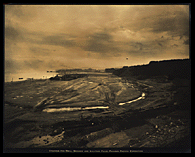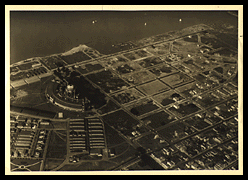

The biggest thing about San Francisco is that it has gone through tremendous land changes and the land change has been dictated mostly by commercial interest. San Francisco had a very wavering waterfront and consisted mostly of sand dunes, that land edge that faced the sea eventually was developed.
This area was a tidal marsh and it really didn't have much commercial value because it was marsh area you really couldn't do much with it. This photograph is a good example of the primary landscape before it changed, before there was enough population to actually force it to change.
San Francisco really had a lot of creeks. Fresh water flowed through this area and eventually joined the tidal marsh.
Over time the land got more and more settled.
The view down to cow hollow and into the waterfront...You really get a sense of how the area was very sparse for a long period of time and then how it eventually changed in large waves.
It eventually had its biggest change after the earthquake. All the rubble from the downtown, some got shipped off to sea and some was brought over and filled the Marina area. Brick and whatever was left of the buildings, brick and rock and mortar. There was a massive amount of rubble that needed to be disposed of.
It was just a convenient place to put it.The biggest change after that was the Panama Pacific International Exposition which was going to celebrate the opening of the Panama Canal in 1915. That became the culmination and focal point of rebuilding San Francisco and declaring its restoration to the face of the world.
 The Marina area in terms of its fill from the earthquake only partially provided the landfill they needed for the Pan Pacific. This was one of the few areas that was actually available to have a large land space developed upon. By reclaiming some of what was essentially just marsh they could provide a large enough space for as ambitious a project as they expected it to be.
The Marina area in terms of its fill from the earthquake only partially provided the landfill they needed for the Pan Pacific. This was one of the few areas that was actually available to have a large land space developed upon. By reclaiming some of what was essentially just marsh they could provide a large enough space for as ambitious a project as they expected it to be.
This was all built for the fair.

Generally, the Panama Pacific International Exposition erased the sense of the earthquake. It erased the sense that San Francisco had been wiped out and had lost its culture.
This was during the war years and the decades that followed it. They're really was not the population base here at this time to expand and fill the area.
The property stood vacant for up to a decade before
the Real Estate developers actually came in.

The story of the Marina is a story of San Francisco itself
because San Francisco is nothing more than yet a great number of hills,
which have since disappeared, but bellow the hills you have nothing
but rolling sand dune.
It's the shifting sands of San Francisco that have been shifted by the Europeans that showed up for the Gold Rush, the Americans that came over land or around the horn, that actually redistributed the sand dunes and created a flat city. What used to be a very sculptural sea line, coastal edge, is now a very square very blocked out piece of terrain.
Its just amazing how much the fill has overtaken the bay.